Forced Magnetostrictions and Magnetizations of Ni2+xMnGa1−x at Its Curie Temperature
Abstract
:1. Introduction
2. Materials and Methods
3. Results and Discussions
3.1. Magnetic Field Dependence of the Magnetization
3.2. Basic Magnetic and Itinerant Spin Fluctuation Parameters and Generalized Rhodes–Wohlfarth Plot
3.3. Magnetization and Temperature Dependences Force Magnetostrictions
4. Conclusions
Author Contributions
Funding
Acknowledgments
Conflicts of Interest
References
- Moriya, T. Spin Fluctuations in Itinerant Electron Magnetism; Springer: Berlin, Germany, 1985; ISBN 978-3-642-82499-9. [Google Scholar]
- Lonzarich, G.; Taillefer, G. Effect of spin fluctuations on the magnetic equation of state of ferromagnetic or nearly ferromagnetic metals. J. Phys. C Solid State Phys. 1985, 18. [Google Scholar] [CrossRef]
- Takahashi, Y. On the origin of the Curie Weiss law of the magnetic susceptibility in itinerant electron magnetism. J. Phys. Soc. Jpn. 1986, 55. [Google Scholar] [CrossRef]
- Takahashi, Y. Theoretical Development in Itinerant Electron Ferromagnetism. J. Phys. Conf. Ser. 2017. [Google Scholar] [CrossRef]
- Takahashi, Y.; Nakano, H. Magnetovolume Effect of Itinerant Electron Magnetism. J. Phys. Condens. Matter 2006, 18. [Google Scholar] [CrossRef]
- Moriya, T.; Kawabata, A. Effect of Spin Fluctuations on Itinerant Electron Ferromagnetism. J. Phys. Soc. Jpn. 1973, 34. [Google Scholar] [CrossRef]
- Moriya, T.; Kawabata, A. Effect of Spin Fluctuations on Itinerant Electron Ferromagnetism. II. J. Phys. Soc. Jpn. 1973, 35. [Google Scholar] [CrossRef]
- Takahashi, Y. Spin Fluctuation Theory of Itinerant Electron Magnetism; Springer: Berlin, Germany, 2013; ISBN 978-3-642-36666-6. [Google Scholar]
- Rhodes, P.; Wohlfarth, E.P. The effective Curie-Weiss constant of ferromagnetic metals and alloys. Proc. R. Soc. Lond. A 1963, 273. [Google Scholar] [CrossRef]
- Nishihara, H.; Harada, T.; Kanomata, T.; Wada, T. Magnetizationprocess near the Curie temperature of an itinerant ferromagnet CoS2. J. Phys. Conf. Ser. 2012, 400, 032068. [Google Scholar] [CrossRef]
- Shimizu, K.; Maruyama, H.; Yamazaki, H.; Watanabe, H. Effect of Spin Fluctuations on Magnetic Properties and Thermal Expansion in Pseudobinary System FexCo1−xSi. J. Phys. Soc. Jpn. 1990, 59. [Google Scholar] [CrossRef]
- Nishihara, H.; Komiyama, K.; Oguro, I.; Kanomata, T.; Chernenko, V. Magnetization processes near the Curie temperatures of the itinerant ferromagnets, Ni2MnGa and pure nickel. J. Alloys Compd. 2007, 442, 191–193. [Google Scholar] [CrossRef]
- Sakon, T.; Hayashi, Y.; Fujimoto, N.; Kanomata, T.; Nojiri, H.; Adachi, Y. Forced magnetostriction of ferromagnetic Heusler alloy Ni2MnGa at the Curie temperature. J. Appl. Phys. 2018, 123. [Google Scholar] [CrossRef]
- Kittel, C. Introduction of Solid State Physics, 8th ed.; John Wiley & Sons Inc.: Hoboken, NJ, USA, 2004; p. 75. ISBN 978-0-471-41526-8. [Google Scholar]
- Matsunaga, M.; Ishikawa, Y.; Nakajima, T. Magneto-volume effect in the weak itinerant ferromagnet MnSi. J. Phys. Soc. Jpn. 1982, 51. [Google Scholar] [CrossRef]
- Sakon, T.; Fujimoto, N.; Kanomata, T.; Adachi, Y. Magnetostriction of Ni2Mn1−xCrxGa Heusler alloys. Metals 2017, 7, 410. [Google Scholar] [CrossRef]
- Matsui, M.; Nakakura, T.; Murakami, D.; Asano, H. Super magnetostriction with mesophase transition of Ni2MnGa. Toyota Sci. Rep. 2010, 63, 27–36. [Google Scholar]
- Matsui, M.; Nakamura, T.; Murakami, D.; Yoshimura, S.; Asano, H. Effect of Super Magnetostriction on Magnetic Anisotropy of Ni2MnGa. Toyota Sci. Rep. 2011, 64, 1–11. [Google Scholar]
- Rizal, C.; Kolthammer, J.; Pokharel, R.K.; Choi, B.C. Magnetic properties of nanostructured Fe-Co alloys. J. Appl. Phys. 2013, 113. [Google Scholar] [CrossRef]
- Singh, S.; Bednarcik, J.; Barman, S.R.; Felsher, S.R.; Pandey, D. Premartensite to martensite transition and its implications for the origin of modulation in Ni2MnGa ferromagnetic shape-memory alloy. Phys. Rev. B 2015, 92. [Google Scholar] [CrossRef]
- Bloch, D.; Voiron, J.; Jaccarino, V.; Wernick, J.H. The high field-high pressure magnetic properties of MnSi. Phys. Lett. A 1975, 51, 259–261. [Google Scholar] [CrossRef]
- Hatta, S.; Chikazumi, S. Magnetization Process in High Magnetic Fields for Fe and Ni in Their Critical Regions. J. Phys. Soc. Jpn. 1977, 43, 822–830. [Google Scholar] [CrossRef]
- Tanaka, Y.; Ishida, S.; Asano, S. Band Calculation of Manganese Magnetic Moments in Ni2MnGa 14M Structure. Mater. Trans. JIM 2004, 45, 1060–1064. [Google Scholar] [CrossRef]
- Khovailo, V.V.; Novosad, V.; Takagi, T.; Filippov, D.A.; Levitin, R.Z.; Vasil’ev, A.N. Magnetic properties and magnetostructural phase transitions in Ni2+xMn1−xGa shape memory alloys. Phys. Rev. B 2004, 70. [Google Scholar] [CrossRef]
- Ueda, U.; Takahashi, M. Structure and Magnetic Properties of Electrodeposited Fe-Ni Alloy Films. J. Phys. Soc. Jpn. 1980, 49, 477–483. [Google Scholar] [CrossRef]
- Webster, P.J.; Ziebeck, K.R.A.; Town, S.L.; Peak, M.S. Magnetic order and phase transformation in Ni2MnGa. Philos. Mag. B 1984, 49, 295–310. [Google Scholar] [CrossRef]
- De Boer, F.R.; Biesterbos, J.; Schinkel, C.J. Ferromagnetism in the intermetallic phase Ni3Al. Phys. Lett. A 1969, 24, 355–357. [Google Scholar] [CrossRef]
- Yoshimura, K.; Takigawa, M.; Takahashi, Y.; Yasuoka, H.; Nakamura, Y. NMR Study of Weakly Itinerant Ferromagnetic Y(Co1−xAlx)2. J. Phys. Soc. Jpn. 1987, 56, 1138–1155. [Google Scholar] [CrossRef]
- Ogawa, S. Electrical Resistivity of Weak Itinerant Ferromagnet ZrZn2. J. Phys. Soc. Jpn. 1976, 40, 1007–1009. [Google Scholar] [CrossRef]
- Aoki, D.; Haga, Y.; Homma, Y.; Sakai, H.; Ikeda, S.; Shiokawa, Y.; Yamamoto, E.; Nakamura, A.; Onuki, Y. First single crystal growth of the Transuranium filled-Skutterudite compound NpFe4P12 and its magnetic and electrical properties. J. Phys. Soc. Jpn. 2006, 75. [Google Scholar] [CrossRef]
- Otto, M.J.; van Woerden, R.A.M.; van der Valk, P.J.; Wijngaard, J.; van Bruggen, C.F.; Haas, C.; Buschow, K.H.J. Half-metallic ferromagnets. I. Structure and magnetic properties of NiMnSb and related inter-metallic compounds. J. Phys. Condens. Matter 1989, 1, 2341–2350. [Google Scholar] [CrossRef]
- Mejía, C.S.; Born, N.O.; Schiemer, J.A.; Felser, C.; Carpenter, M.A.; Nicklas, M. Strain and order-parameter coupling in Ni-Mn-Ga Heusler alloys from resonant ultrasound spectroscopy. Phys. Rev. B 2018, 97, 094410. [Google Scholar] [CrossRef] [Green Version]
- Seiner, H.; Kopecky, V.; Landa, M.; Heczko, O. Elasticity and magnetism of Ni2MnGa premartensitic tweed. Phys. Status Solidi B 2014, 251, 2097–2103. [Google Scholar] [CrossRef]
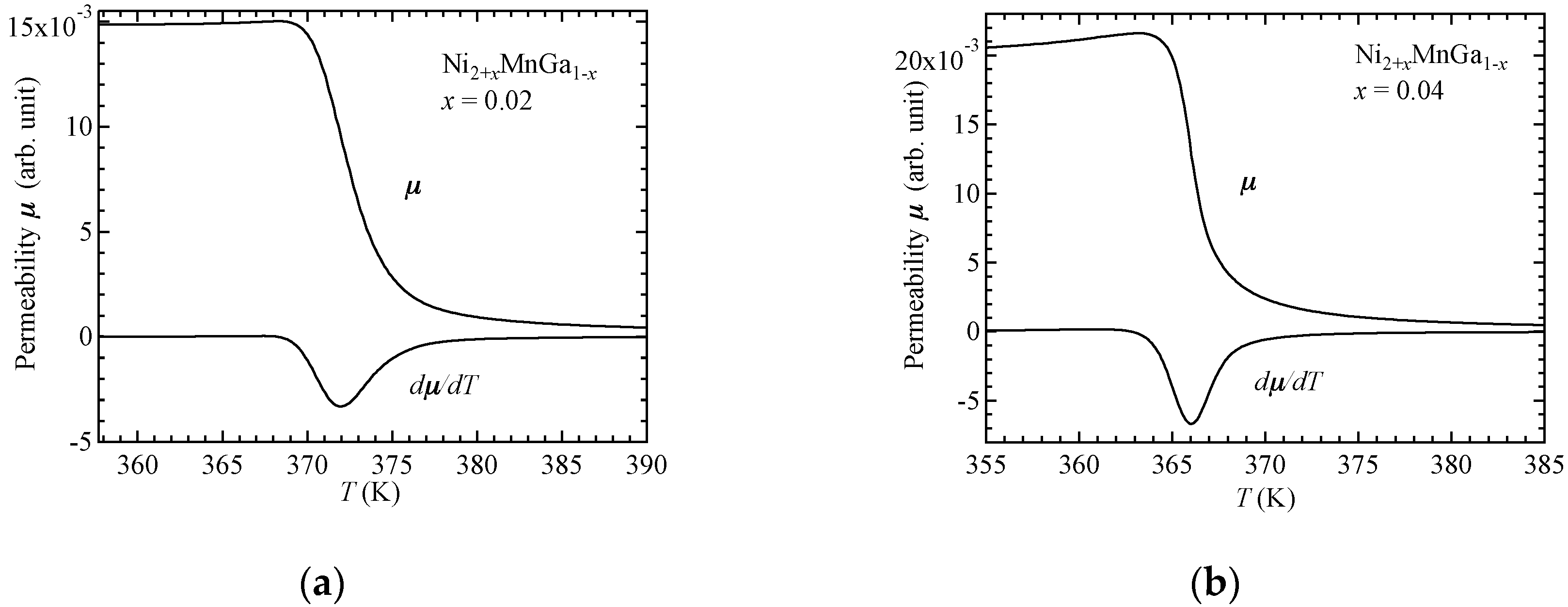
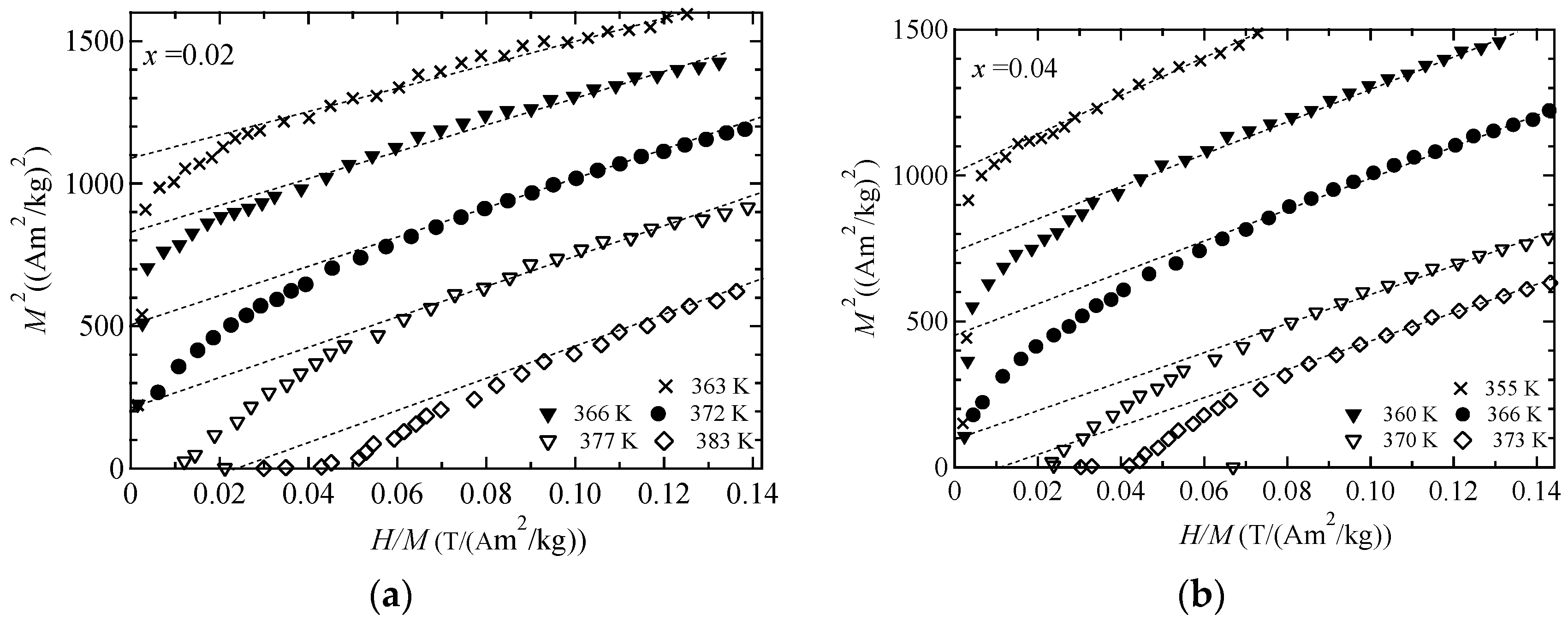
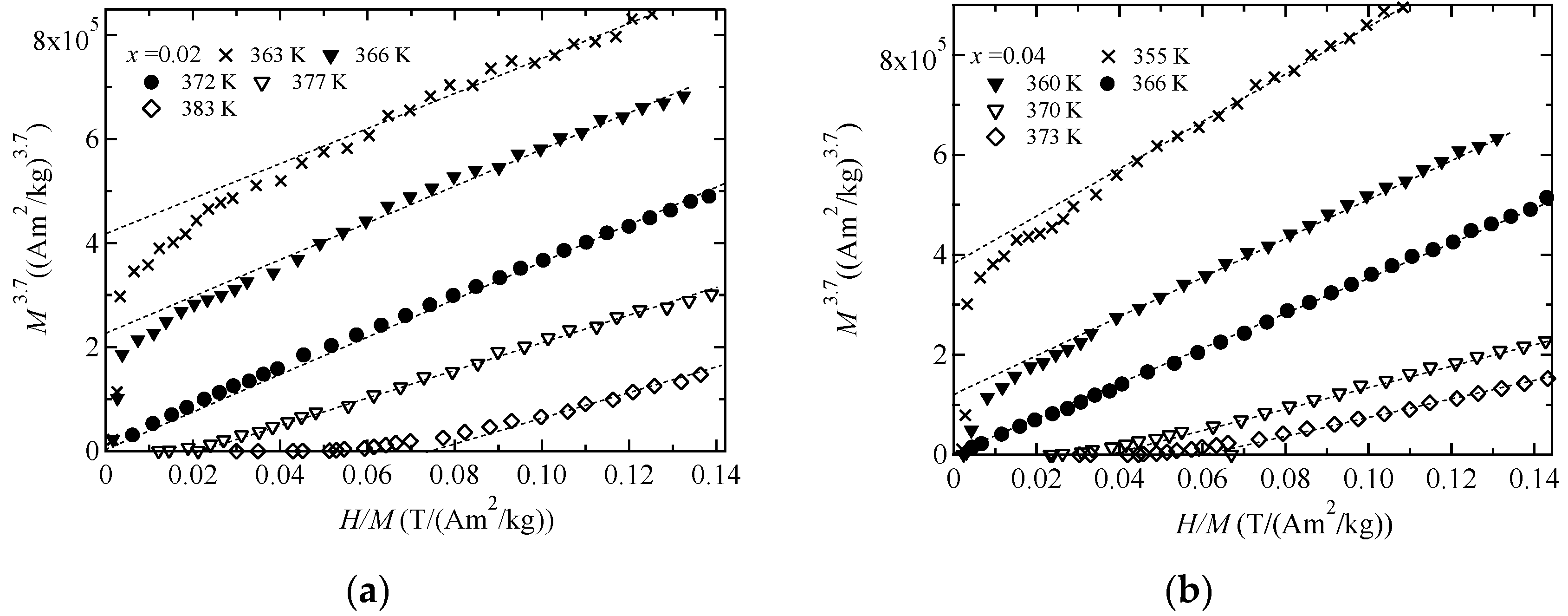

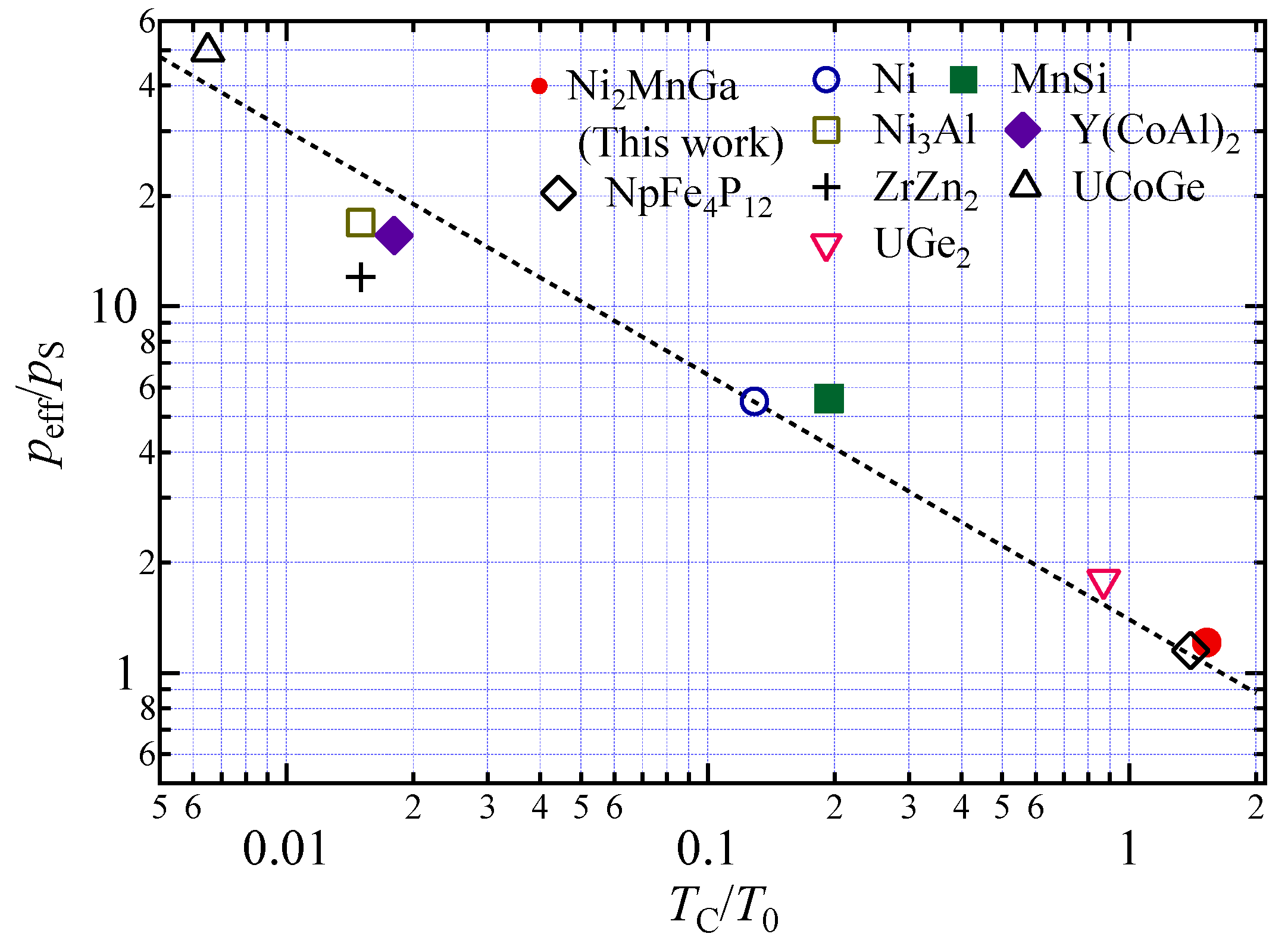

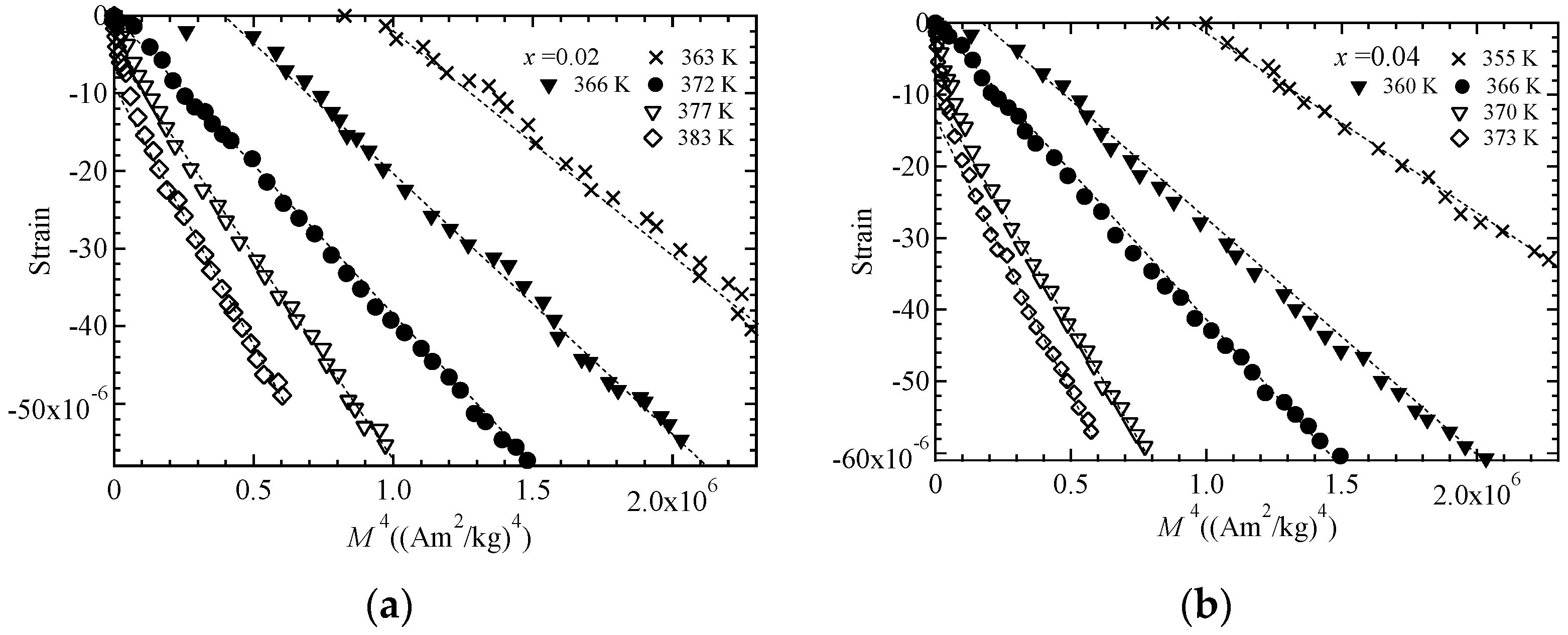

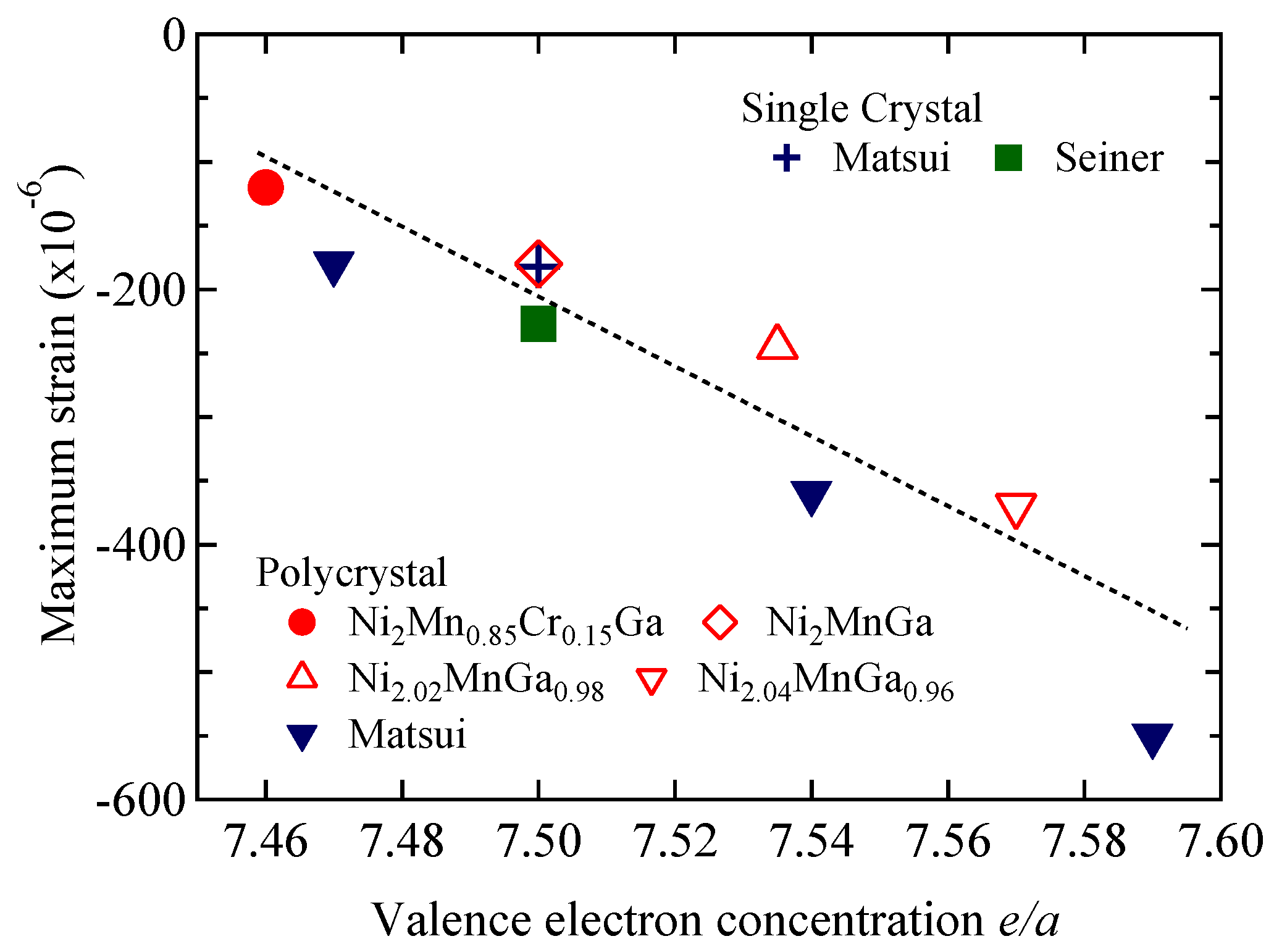
| x | pS (μB) | TC (K) | TA (K) | T0 (K) |
|---|---|---|---|---|
| 0.00 | 3.93 | 375 | 563 | 245 |
| 0.02 | 3.79 | 372 | 566 | 288 |
| 0.04 | 3.64 | 366 | 567 | 345 |
| TC (K) | peff (μB) | pS (μB) | peff/pS | TA (K) | T0 (K) | TC/T0 | km | Reference | |
|---|---|---|---|---|---|---|---|---|---|
| Ni2MnGa | 375 | 4.75 * | 3.93 | 1.21 | 563 | 245 | 1.53 | 1.61 | This work, [26] * |
| Ni | 623 | 3.3 | 0.6 | 5.5 | 1.76 × 104 | 4.83 × 103 | 0.129 | 1.41 | [12] |
| MnSi | 30 | 2.2 | 0.4 | 5.3 | 2.08 × 103 | 231 | 0.13 | 1.88 | [21] |
| Ni3Al | 41.5 | 1.3 | 0.075 | 17.3 | 3.09 × 104 | 3.59 × 103 | 0.016 | 1.06 | [27] |
| Y(Co0.85Al0.15)2 | 26 | 2.15 | 0.138 | 15.6 | 0.726 | 1.41 | 0.018 | 1.08 | [28] |
| ZrZn2 | 17 | 1.44 | 0.12 | 12 | 8.83 × 103 | 321 | 0.053 | 0.74 | [29] |
| UCoGe | 2.4 | 1.93 | 0.039 | 49.5 | 5.92 × 103 | 362 | 0.0065 | 1.74 | [8] |
| UGe2 | 52.6 | 3.00 | 1.41 | 2.13 | 442 | 92.2 | 0.571 | 1.61 | [8] |
| NpFe4P12 | 23 | 1.55 | 1.35 | 1.15 | 285 | 16.4 | 1.40 | 1.44 | [30] |
| δ = 2 | δ = 4 | |||
|---|---|---|---|---|
| x | 0.02 | 0.04 | 0.02 | 0.04 |
| A | 3.60 × 10−5 | 1.65 × 10−7 | 3.29 × 10−5 | −7.06 × 10−7 |
| Standard deviation of A | ±1.20 × 10−6 (3.3% of A) | ±1.73 × 10−7 105% of A) | ±1.04 × 10−6 (3.2% of A) | ±2.72 × 10−7 (38% of A) |
| y0 = A/(Strain at 5 T) | 58% | 0.3% | 53% | 1.2% |
| k | −7.62 × 10−8 | −3.93 × 10−11 | −7.58 × 10−8 | −4.11 × 10−11 |
| Standard deviation of k | ±1.2 × 10−9 (1.5% of k) | ±2.08 × 10−13 (0.5% of k) | ±1.03 × 10−9 (1.4% of k) | ±3.36 × 10−13 (0.8% of k) |
© 2018 by the authors. Licensee MDPI, Basel, Switzerland. This article is an open access article distributed under the terms and conditions of the Creative Commons Attribution (CC BY) license (http://creativecommons.org/licenses/by/4.0/).
Share and Cite
Sakon, T.; Hayashi, Y.; Li, D.; Honda, F.; Oomi, G.; Narumi, Y.; Hagiwara, M.; Kanomata, T.; Eto, T. Forced Magnetostrictions and Magnetizations of Ni2+xMnGa1−x at Its Curie Temperature. Materials 2018, 11, 2115. https://doi.org/10.3390/ma11112115
Sakon T, Hayashi Y, Li D, Honda F, Oomi G, Narumi Y, Hagiwara M, Kanomata T, Eto T. Forced Magnetostrictions and Magnetizations of Ni2+xMnGa1−x at Its Curie Temperature. Materials. 2018; 11(11):2115. https://doi.org/10.3390/ma11112115
Chicago/Turabian StyleSakon, Takuo, Yuhi Hayashi, Dexin Li, Fuminori Honda, Gendo Oomi, Yasuo Narumi, Masayuki Hagiwara, Takeshi Kanomata, and Tetsujiro Eto. 2018. "Forced Magnetostrictions and Magnetizations of Ni2+xMnGa1−x at Its Curie Temperature" Materials 11, no. 11: 2115. https://doi.org/10.3390/ma11112115
APA StyleSakon, T., Hayashi, Y., Li, D., Honda, F., Oomi, G., Narumi, Y., Hagiwara, M., Kanomata, T., & Eto, T. (2018). Forced Magnetostrictions and Magnetizations of Ni2+xMnGa1−x at Its Curie Temperature. Materials, 11(11), 2115. https://doi.org/10.3390/ma11112115




